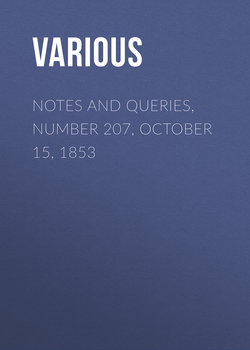Читать книгу Notes and Queries, Number 207, October 15, 1853 - Various - Страница 2
Notes
COMET SUPERSTITIONS IN 1853
ОглавлениеFrom the 19th of August to the present time that brilliant comet, which was first seen by M. Klinkerfues, at Göttingen, on the 10th of June last, has been distinctly visible here, and among the ignorant classes its appearance has caused no little alarm. The reason of this we shall briefly explain.
During the past fifty-five years the Maltese have grievously suffered on three different occasions; firstly, by the revolution of 1798, which was followed by the plague in 1813; and lastly, by the cholera in 1837. In these visitations, all of which are in the recollection of the oldest inhabitants, thirty thousand persons are supposed to have perished.
Mindful as these aged people are of these sad bereavements, and declaring as they do that they were all preceded by some "curious signs" in the heavens which foretold their approach, men's minds have become excited, and, reason as one may, still the impression now existing that some fatal harm is shortly to follow will not be removed.
A few of the inhabitants, more terrified than their neighbours, have fancied the comet's tail to be a fiery sword, and therefore predict a general war in Europe, and consequent fall of the Ottoman Empire. But as this statement is evidently erroneous, we still live in great hopes, notwithstanding all previous predictions and "curious signs," that the comet will pass away without bringing in its train any grievous calamity.
By the following extracts, taken from some leading journals of the day, it will be seen that the Maltese are not alone in entertaining a superstitious dread of a comet's appearance. The Americans, Prussians, Spaniards, and Turks come in the same list, which perhaps may be increased by your correspondents:
"The Madrid journals announce that the appearance of the comet has excited great alarm in that city, as it is considered a symptom of divine wrath, and a presage of war, pestilence, and affliction for humanity."—Vide Galignani's Messenger of August 31, 1853.
"The entire appearance (of the comet) is brilliant and dazzling; and while it engrosses the attention and investigation of the scientific, it excites the alarm of the superstitious, who, as in ancient times, regard it as the concomitant of pestilence and the herald of war."—Vide New York correspondence of The Sun, Aug. 24, 1853.
"The splendid comet now visible after sun-set on the western horizon, has attracted the attention of every body here. The public impression is, that this celestial phenomenon is to be considered as a sign of war; and their astrologers, to whom appeal is made for an interpretation, make the most absurd declarations: and I have been laughed at by very intelligent Turks, when I ventured to persuade them that great Nature's laws do not care about troubles here below."—Vide Turkish correspondence of The Herald, Aug. 25, 1853.
"The comet which has lately been visible has served a priest not far from Warsaw with materials for a very curious sermon. After having summoned his congregation together, although it was neither Sunday nor festival, and shown them the comet, he informed them that this was the same star that had appeared to the Magi at the birth of our Saviour, and that it was only visible now in the Russian empire. Its appearance on this occasion was to intimate to the Russian eagle, that the time was now come for it to spread out its wings, and embrace all mankind in one orthodox and sanctifying church. He showed them the star now standing immediately over Constantinople, and explained that the dull light of the nucleus indicated its sorrow at the delay of the Russian army in proceeding to its destination."—Vide Berlin correspondence of The Times.
W. W.
Malta.
